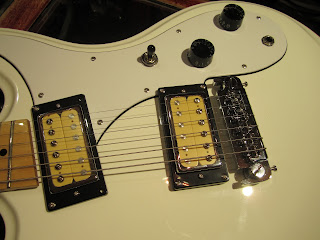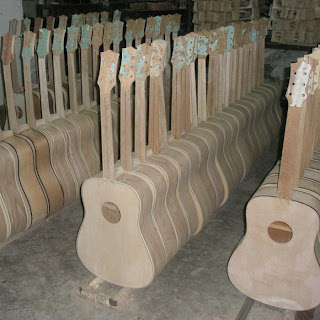When this guitar came out of the box the other day in the shop, I was instantly excited. The Hi-Flyer is a re-issue of the Univox model of the same name which first appeared roughly around 1977. Univox was an arm of the Unicord corportion (which was eventually an arm of the Gulf+western company..). They began with amplifiers and in 1968 merged with the Merson company to begin importing guitars. There were four phases of the Hi-Flyer model (which was essentially a riff on the Ventures Mosrite guitar) with Phase 4 being the last one produced. This version most notably did away with a tremolo system and added a gibson style hardtail bridge. Possibly the reason the Phase 4 is most well known these days is for Kurt Cobain's use of it in the "Heart Shaped Box" video. Let me be clear...I am NOT a nirvana fan boy at all. In fact I never got too excited about Nirvana. This post is not an homage to a guitar based on Kurt Cobains use of it. I just love this damn thing! From it's killer looks to the impressive pickups, it has it all!
The guitar features a basswood body and maple bolt on neck. The neck has a satin finish to it, which I love. I've never enjoyed playing an overly lacquered neck as it tends to get sticky and uncomfortable very fast. The nut is a comfy 1 5/8" and has a gibson style scale length at 24 3/4". I've always prefered the longer strat style scale length but this bad boy still feels very comfy and the double cutaway gives you nice access to the higher frets. The electronics are simple and straight forward: One volume, one tone and a three way toggle switch. No coil tapping on this guitar but that certainly doesn't impeded it anyway. The Phase 4 eastwood humbuckers sound incredible! I was very impressed with them both clean and driven. To top it off, they look bad ass in their clear coverings and slight angled settings. Adding even more to the wow factor is the Mintech 3 way adjustable wrap around tailpiece. This is a super adjustable hard tail that lets you intonate the guitar as needed. Not a common feature in many hard tail guitars.
The Hi-Flyer does not come with a case but eastwood brand hardcases are available and generally cheap (somewhere around $130). It's a small loss considering this axe is merely $599 and sounds/looks incredibly cool. It may not be the high end guitar you treasure all your life, but it is definitely the guitar you take to every gig and give it one hell of an active lifestyle. Below I have a quick 30 second video to let you hear the guitar. I did record a dirty version as well but i managed to delete it off my camera..so bear with just hearing it clean! Thanks to my fellow employee Ariel for the demo.
To learn more on Eastwood's other killer vintage re-issues check them out at www.eastwoodguitars.com. Pop by Rudy's sometime and see the one we have before it's snatched up! I'll be happy to show you!
-K.






















